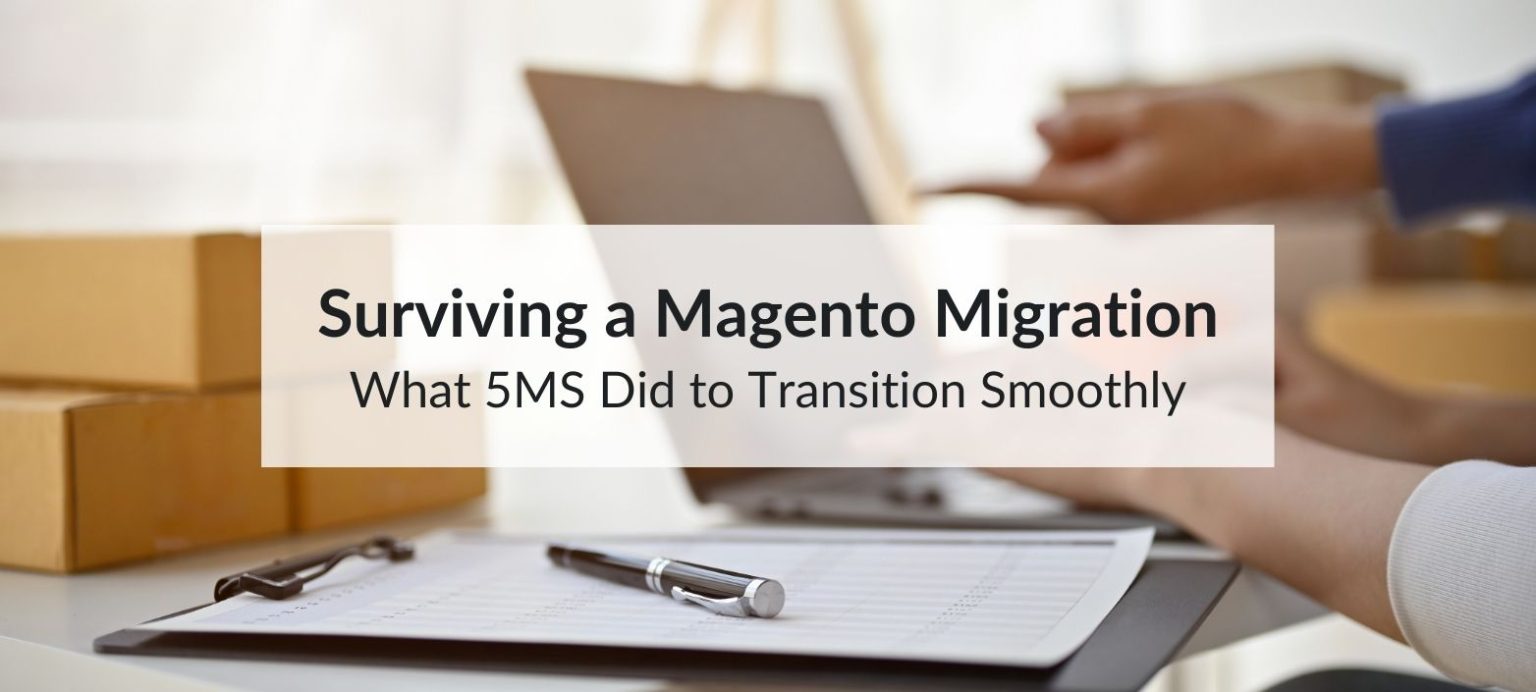Migrating a Magento store can be a daunting task. From data transfer and plugin compatibility to user experience and SEO, a migration involves risks that, if not managed properly, can lead to lost revenue and frustrated customers. At 5MS, we recently completed a Magento migration, and here’s what we cannot stress about with every Magento migration we complete ensuring a seamless transition with zero downtime.
Table of Contents
Why a Magento Migration is Essential
Magento migrations happen for a variety of reasons:
- Upgrading from Magento 1 to Magento 2: Magento 1 no longer receives support. Security, performance, and compatibility issues are common with outdated versions.
- Scaling for Growth: Expanding businesses often need advanced features, better integrations, or improved performance. A Magento upgrade can deliver these benefits.
- Enhancing Site Performance: A migration can boost speed, mobile usability, and SEO to meet user expectations and search engine standards.

For 5MS, transitioning from Magento 1 to Magento 2 improved security, scalability, and user experience. Here’s the step-by-step strategy we followed.
Step-by-Step: Ensuring a Smooth Magento Migration
Migrating a Magento store involves several steps, each crucial for a successful transition. Here’s how we navigated each phase.
Pre-Migration Planning and Testing
Planning is essential to minimize risks. To begin with, we mapped out every aspect of the store, including databases, plugins, themes, and custom code.
- Data Backup and Storage: A complete site backup ensured all customer, product, and order data was safely stored.
- Staging Environment Setup: Our developers tested every aspect of the new Magento 2 setup in a staging environment without disrupting the live store.
- Testing Magento 2 Extensions for Compatibility: Furthermore, we reviewed all active themes and extensions. For example, some extensions were no longer supported, so we researched alternatives and updated configurations.
Pro Tip: A staging environment helps catch potential issues before they affect your live site.
Customer Data: Transferring It Right
Data migration is often the most sensitive part of a Magento migration. Here’s how we tackled it:
- Customer and Order Data Migration: Using the Magento Data Migration Tool streamlined this process. As a result, we avoided any significant data discrepancies.
- Database Optimization: We cleaned the database by removing outdated product information and duplicates.
- Testing for Accuracy: In addition, we validated product details, customer records, and order histories to ensure consistency.
Quick Insight: Magento’s Data Migration Tool is useful, but have a developer tailor the process to your store’s needs.
SEO Preservation: Protecting Rankings
SEO can be heavily impacted during migration. To address this, we:
- 301 Redirects: Redirected old URLs to new ones to prevent 404 errors and ranking drops.
- Meta Data and Canonical Tags: Configured metadata and canonical tags to avoid duplicate content issues.
- XML Sitemap Update: For better results, we submitted a new sitemap to Google Search Console to index the updated site quickly.
Pro Tip: Monitor Google Search Console during migration to catch indexing issues early.
Extensions and Customizations
Magento’s flexibility comes with complexity, especially for custom features. Here’s how we managed this step effectively:
- Prioritize Essential Extensions: We audited and prioritized must-have extensions for Magento 2.
- Rebuilding Custom Features: For instance, tailored checkout experiences required rebuilding.
- Compatibility Testing: Moreover, all extensions were tested on the staging site to confirm they worked correctly.
Final Testing Before Going Live
Before switching, we conducted rigorous testing:
- Performance and Speed Tests: Tools like GTMetrix ensured the site met performance standards.
- Mobile and Cross-Browser Testing: To improve user experience, we tested the site on various devices and browsers.
- User Journey Checks: From start to finish, we verified functionality and navigation from homepage to checkout.
Quick Tip: Load tests prepare your hosting for peak traffic.
Going Live with Zero Downtime
Finally, we scheduled the Magento migration during off-peak hours. For instance, our hosting provider assisted in ensuring a seamless transition.
- Switching the DNS: DNS settings were updated to direct traffic to the new site.
- Monitoring for Issues: Additionally, we monitored performance and customer feedback post-migration.
- Backup Plan: Just in case, our backup data was ready for restoration.
Post-Migration: What We Learned
After completing the migration, we reviewed our performance.
What Worked Well:
- SEO Retention: Effective redirects and metadata preservation helped maintain rankings and even boosted organic traffic.
- Enhanced Performance: Page load times improved by 30%, creating a smoother user experience.
- Customer Satisfaction: Extensive testing ensured uninterrupted user journeys and positive feedback on the new design.
Where We Can Improve:
- Customization Documentation: Some custom features were harder to migrate than expected. Thorough documentation will simplify future upgrades.
- Enhanced Monitoring: More detailed post-migration monitoring could help catch minor issues faster.
Key Takeaways for a Successful Magento Migration
Considering a Magento migration? Here are our recommendations:
1. Plan with a Staging Environment: Test extensively in a controlled environment to prevent live-site issues.
2. Prioritize SEO: Protect SEO rankings by maintaining redirects, metadata, and sitemaps.
3. Audit Extensions and Customizations: Focus on essential extensions and ensure custom features are migration-ready.
4. Monitor Post-Migration: Track site performance and user feedback immediately after launch to address any issues.
Conclusion: The Key to a Smooth Magento Migration
Migrating a Magento store requires careful planning and execution. By prioritizing data accuracy, SEO retention, and rigorous testing, we ensured a smooth transition with no downtime. Whether you’re upgrading from Magento 1 or scaling for growth, a well-executed strategy will make all the difference.

